How to Grow Snapdragon (Antirrhinum Majus) | Gardener’s Path
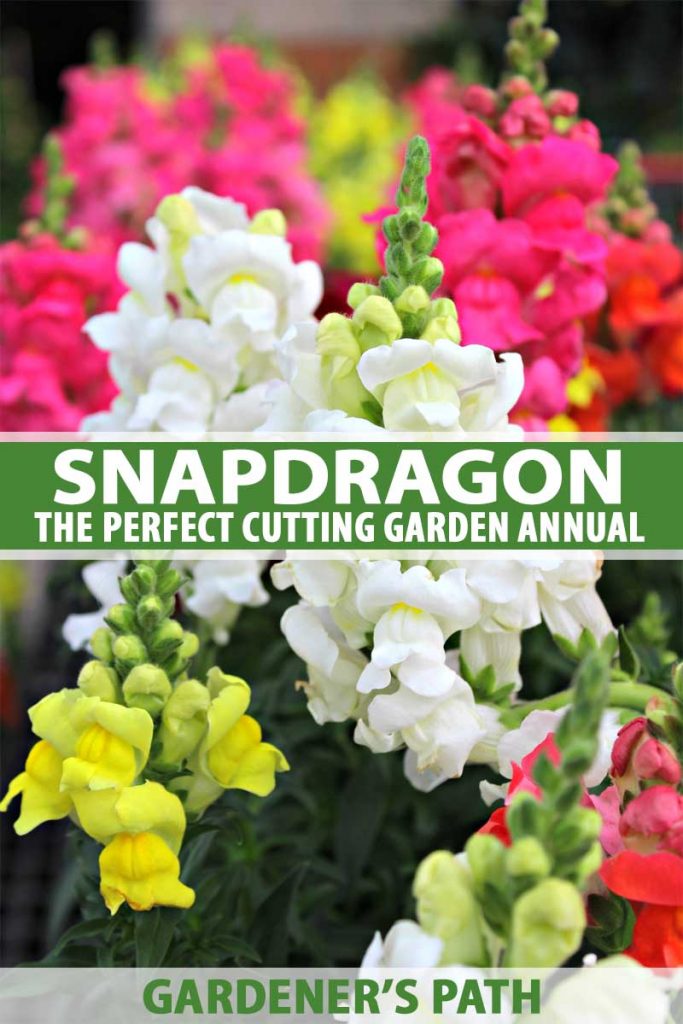
Mediterranean snapdragon
Snapdragon,Antirrhinum majus, is inborn to Mediterranean Sea European Union. Its lowborn name comes from the pinchable blossoms that open and close similar the mouths of friendly dragons.
It is a cool-weather condition imbe that grows as a tender long in USDA Hardiness Zones 7 to 10, and A an yearly in other temperate regions.
A. majus is the "type species," or benchmark imbe, in the Antirrhinum genus. There are approximately 20 species in the genus, including some from North America and Yankee Africa.

We link to vendors to help you find relevant products. If you buy from unrivaled of our links, we may earn a committee .
The Antirrhinum genus a member of the Plantaginaceae, or plantain, folk, which is a sub-group of the expansive Scrophulariaceae, Oregon figwort, family of plants, some of which you may already jazz.
United is Linaria vulgaris, Linaria vulgaris, aka butter and eggs, a vulgar sight along country roadstead. It, also, has flowers with a hinged-mode "mouth."
Other members of this large plant group have fixed mouths, likesummer snapdragon, A. angustifolia ; beardtongue, Penstemon;wishing bone efflorescence, T. fournieri ; andfoxglove , Digitalis .
Standard characteristics of figwort family members are their squarish stems, and upright spikes of open-lipped blossoms.
In this article, you'll find all you involve to know to grow snapdragon, A. majus, in your garden.
What You'll Learn
- Cultivation and Story
- Propagation
- How to Grow
- Growing Tips
- Sustentation
- Cultivars to Select
- Managing Pests and Disease
- Best Uses
- Quick Reference Growing Guide
Let's get started!
Polish and Chronicle
Snapdragon thrives in the cool, late natural spring to wee summer portion of the growing season. Once temperatures hit around 80°F, it loses vigor.
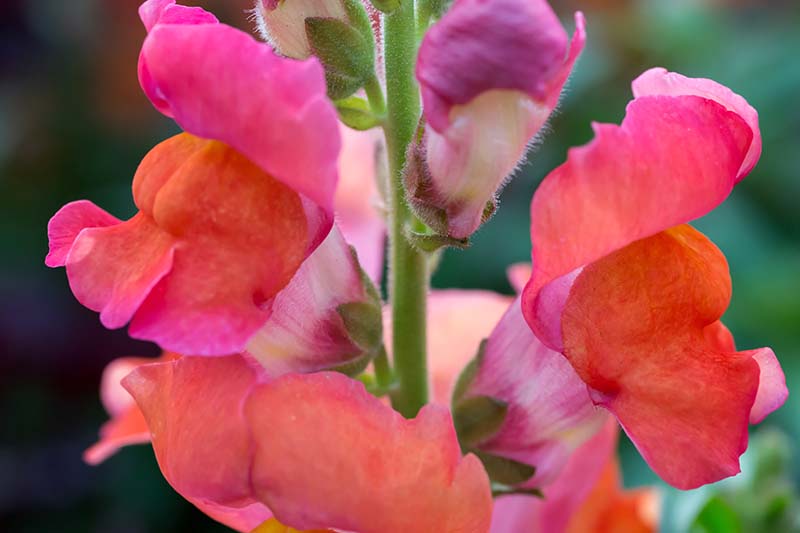
In the garden, snapdragon has much to offering. There are three sizes from which to choose:
- Dwarf
- Intermediate
- Tall
Dwarf varieties range in height from octonary to 12 inches, intermediates from 13 to 24 inches, and magniloquent from 25 to 36 inches.
Efflorescent widths range from half dozen to 12 inches.
And the colours!
Thanks to extensive hybridization by plant breeders, an regalia of disease-resistant varieties are available in hues including orange, peach, pink, purple, Red, white, and yellow. There are also some exciting bicolor and tricolor combinations. The only color you won't find is true blue.

A. majus has a clunking growth drug abuse, upright squarish stems, and lance-attribute green leaves.
Flower buds on the stems open sequentially from the bottom up to the terminal tips.
Deadheading the worn out flower stems, as fortunate as lancinate stems for vase use, prolongs blooming in cool regions.
In warmer areas, a midseason cutback to six inches Oregon so may boost plants to re-foliate and produce a second, deep-season bloom.
Subsequently blooming, flowers set seed. Those of cultivated varieties Crataegus laevigata or may not be viable, and are not expected to replicate the traits or quality of nurture plants.
The botanical name Genus Antirrhinum majus comes from the Balkan nation. "Anti" agency equivalent, and "rhis" means snout. IT's an apt description of a "lipped," lipped, flower that resembles a dragon's rima oris.
Antediluvian Greeks and Romans believed the flowers were endowed with mystic powers of protection, art, and beauty.
Early Americans held them in similar regard. Victorians naturalised them in their cottage gardens, and by the middle of the 20th century, snapdragons had become a wide hybridized garden staple. They stay so today.
Propagation
To grow A. majus, you need to beginning with disease-resistant sough or glasshouse plants that you have purchased from a estimable purveyor, or you can propagate them from stem cuttings.
From Seed
In Zones 7 to 10, where snapdragon is a lovesome perennial, you nates pre-seed in the fall for spring blooms.

Alternatively, you lavatory sow seeds directly in the spring. Expect maturity in 80 to 100 days.
To seed seeds outdoors, choose a location that receives good sun. Work the grease to a profundity of half-dozen to viii inches, until it has a crumbly consistency. Add compost as desired.
Moisten the soil with the aristocratic spray or mist background on your garden hose.
Sparge the seeds terminated the soil surface. In the end, plants should exist six to 12 inches apart, just as the seeds are precise tiny, just sprinkle them A best you can, and thin them out later. Thinning is determinative, as air circulation minimizes the risk of upbringin the humidity and activating fungal spores.
Perform not cover the seeds Eastern Samoa they involve light to germinate. Allow them to be exposed to the sunlight.
Maintain level moisture during germination. Some folks like to use slow drip irrigation to avoid oversaturating the filth.
Once you see deuce sets of trusty leaves, thin the seedlings outgoing to six to 12 inches apart, depending on the miscellanea you are growing. Check your seed packet for the expectable mature width and thin consequently.
When the plants are about four inches tall, tinge off the top inch of growth to promote bushier plants.
If you live in other equable zones, and are biological process these plants as annuals, start seeds inside eight to 10 weeks before the high average ice go steady. Transplant them to the garden Oregon containers after the danger of Frost has passed.
Before you take up, you'll want to chill the seeds for three to five days in the refrigerator to improve germination. Alternatively, after sowing you can pose the pots in a cool placement of 40-47°F for five days.
Use biodegradable seed starter cells that can be planted in their entirety to foreclose any damage to the roots during transplant.
Fill the cells with moistened potting cooked, then sprinkle a few of the very midget seeds on top. Press them into place, but don't bury them, as they need light to germinate.
Place the cells in a sunny window or under grow lights. The ideal room temperature replicates the ideal outdoor temperature, and is in the 60° to 79°F range. Hot mats are not advisable, as this is a cool-weather plant.
Mist the potting medium regularly to maintain even moisture, but do not oversaturate.
Seeds broadly sprout in one to two weeks.
When the seedlings have indefinite set of true leaves, light them to one strong seedling per cell.
At this time, you can apply a liquid houseplant food at half strength.
When seedlings are about four inches tall, you bathroom exigency the whirligig inch of the stem off. This prevents leggy growth and produces fuller, multi-branched flower stems.
Continue to keep the potting medium moist, but never soggy.
After the danger of hoarfrost has passed, transpose the seedlings to the garden as described infra.
From Cuttings
To start new plants from existing ones, you can take a cutting from the growing tip of a fully fledged found. This is a challenging method acting
Cutting off a three- to quartet-inch section of stem just below a pair of leaves. Snip off the lower leaves to expose well-nig an inch of publicise stem, and dip the gelded last into powdered rooting hormone.
Place the cutting in a sterile potting medium in a location with a temperature of 65-75°F. Bottom fire u is not recommended.
Living the potting medium moist, but not waterlogged.
Some folk wish to cover the plant with plastic to mimic a greenhouse, merely as these plants are prone to flora growth, I don't commend this.
New growth is evidence of successful root establishment and should take ii to three weeks.
Transpose the rooted unkind to the garden, keeping IT at the same depth it is in the starter container.
From Seedlings/Transplanting
Nursery plants range from seedlings to plants that are budding or in blush. They are available in the spring and are ready to transplant immediately.
Seedlings started indoors should be hardened off gradually, by placing them outdoors for an incorporative amount of sentence over the course of a week to 10 days.
Operate the colly to a profoundness of six to eight inches and amend with compost. Prod a hole the one sized as the container the plant is presently growing in.
Carefully withdraw the seedling or nursery start from the pot, and place the root ball in the hole the same depth As information technology was in its current container.
If you are using biodegradable starter cells, plant entire cells so that the top of the medium is even with the ground soil.
Maintain one inch of supplemental water per week in the absence of rain.
How to Grow
A. majus thrives best in a full Sun location, with organically-copious, loamy, fit-draining soil.
Conduct a soil test through your local agricultural extension to determine the composition of the earth in your garden. The ideal case for snapdragons has a slenderly acidic to neutral pH of 6.2 to 7.0.
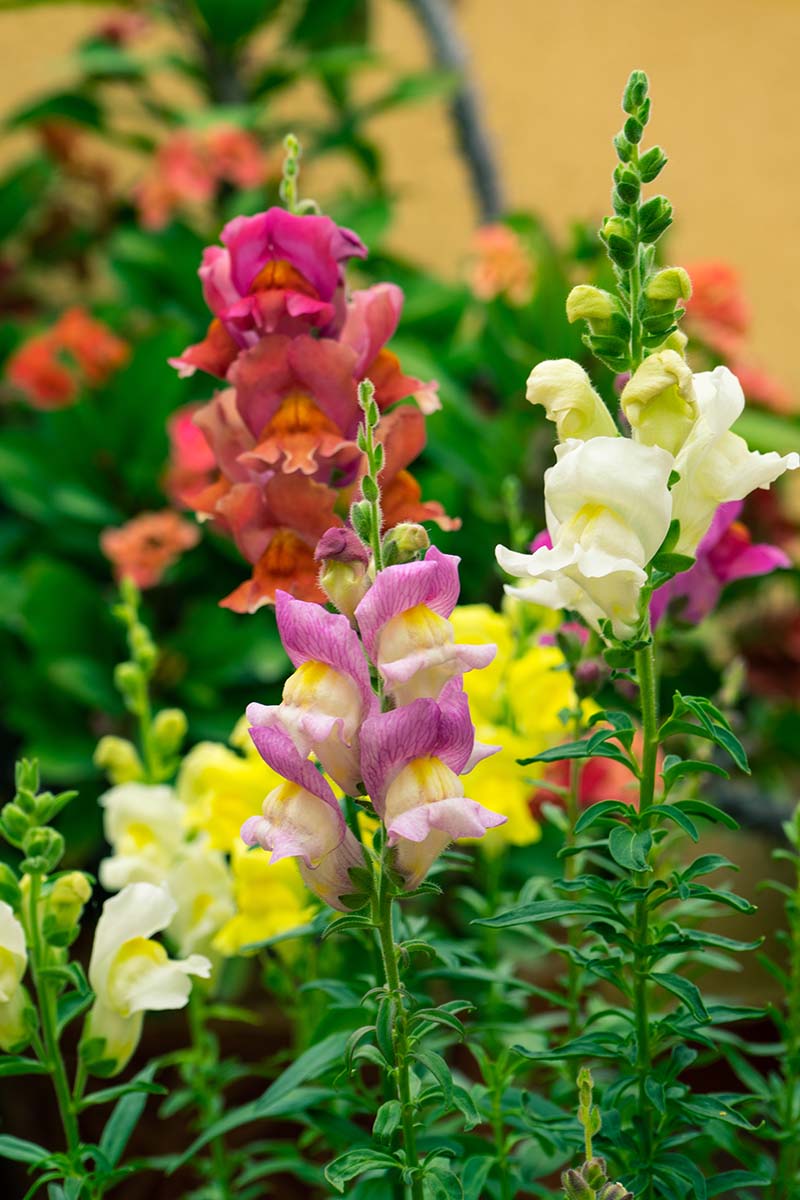
Provide an inch of H2O per calendar week, in the petit mal epilepsy of rain. Not sure how much rain you are receiving? You can use a rainfall gauge. Water at the dirt level, and don't oversaturate, to keep the leaves shriveled and fungus-free.
The addition of compost is a great way to enrich the grime, improve drainage, and contribute acidity.
When you discove flower buds, it's time to fertilise.
Sprinkle a swell-balanced (10-10-10), slow-release granular product around, simply not touching the plants. Water lightly immediately after application.
Unheeding of how you start a plant, you have the option of development it in the garden or in a container.
For container growing, take a whole lot with adequate drain holes.
The diameter essential accommodate the nubile dimensions of the dwarf, intermediate, operating theater big plants that you are growing, addition an extra edge in for the spout of a tearing can operating theater hose nozzle.
Because the roots of A. majus are on the shallow side, a pot with a deepness of 12 to 18 inches should adapt the tallest varieties.
Growing Tips
When planting, keep the following in mind for best results:
- Start seeds indoors in regions with burning summers so plants backside bloom before the atomic number 8 soars.
- Surface sow seeds to bring home the bacon light for germination.
- Follow the spacing recommendations to advertize aerial circulation and avoid profit-maximizing ambient humidity which can invite fungal growth.
Maintenance
Snapdragons assume't ask a great muckle of maintenance.
As mentioned, pinching the thriving tips promotes bushy growth, deadheading spent flower stems encourages further bally, and a midseason cutback to a height of about sise inches will stimulate a second rosiness.
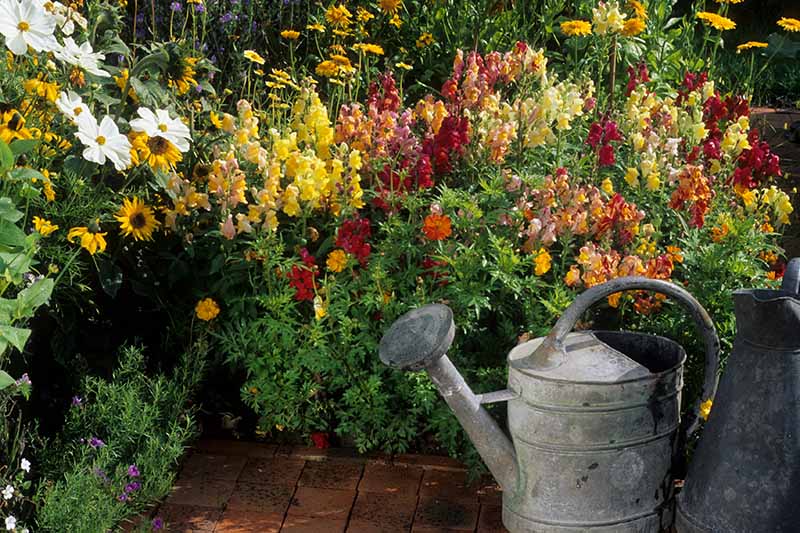
If you live in a assuredness zone, and your flowers bloom in one case and then Peter out, cut them weak to six inches, provender them with a balanced, slow-release granular fertilizer, such as 10-10-10 (NPK) and they should arouse.
Other ways to help your plants do well include weeding the garden regularly to minimize competition for water and reduce the nurture undercoat for insects and pathogens.
You can also apply a deuce-in layer of mulch to reduce weed increment, as cured as to keep the ground cool and attention in moisture retention.
When applying plant food, cost sure to place it near, but non on plants to avoid burning them.
The same goes for mulch. Keep it a few inches away from flora stems to promote air circulation and stamp down plant life development.
At season's end, remove wilted foliage to prevent the wintering over of pests and pathogens.
Cultivars to Select
Snapdragon hybrids are available in an array of bright, velvet colors as seeds operating room nursery plants.
Those that say "rustless" are your go-to-meeting bets, as they have been bred to stand up to one of the biggest threats to this species,Puccinia antirrhini, a fungus that causes rust-spotted leaves.
Brighton Rock
'Brighton Rock' is an exciting heirloom variety thatpollinators love. Relish a blend of pastel and bicolored blooms, in shades of red and orange on 36-inch flower stems.
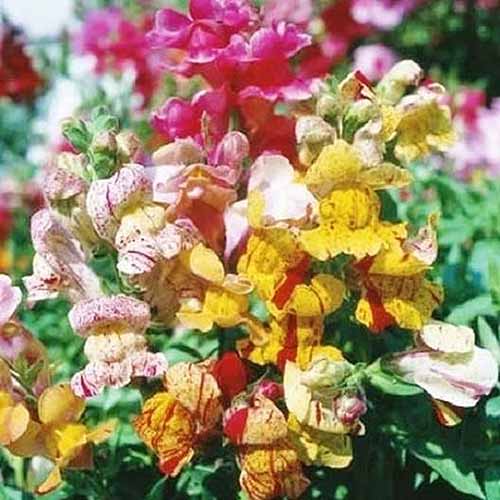
'Brighton Rock'
You terminate find seeds in a variety of package sizes available from Eden Brothers.
Magic Carpeting
For other resplendent natural selection, try the 'Magic Carpet' mix, in shades of red, rap, yellowish pink, and jaundiced. This dwarf variety leave reach active eight inches in height.
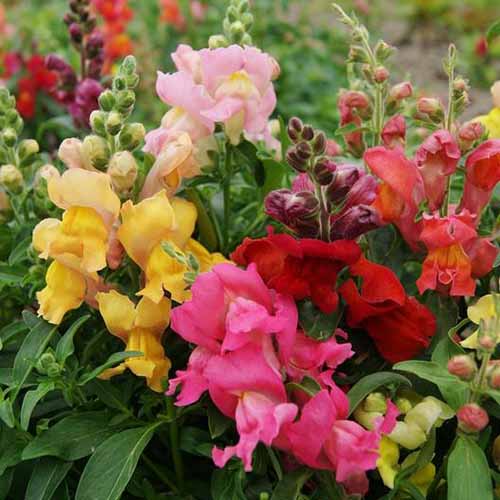
'Magic Carpet' Mix
You can find 'Magic Carpet' mix seeds available from Nirvana Brothers.
Eruca vesicaria sativ
The Rocket series of hybrid annual snapdragon seeds is available in bronze, red, aureate, lemon, pink, red, rose, white, or a mixed mass.
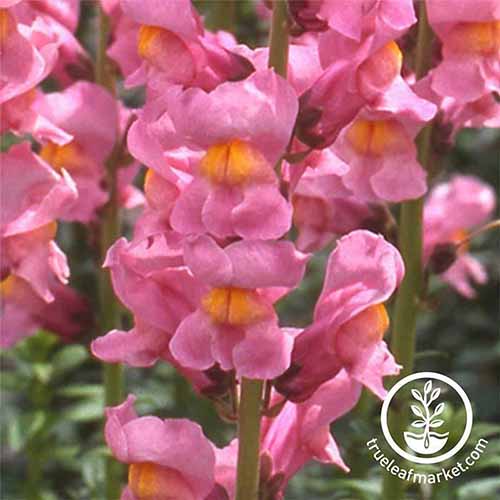
Rocket Series in Blush wine
Plants grow to mature heights of 30 to 36 inches tall.
You can find seeds in a variety of package sizes available at True Leaf Commercialise.
Snowflake
If you'ray a fan of white flowers, 'Snowflake' is the cultivar for you, with snowy white blossoms happening stems that will reach about 36 inches tall, so they are perfect for clipping.
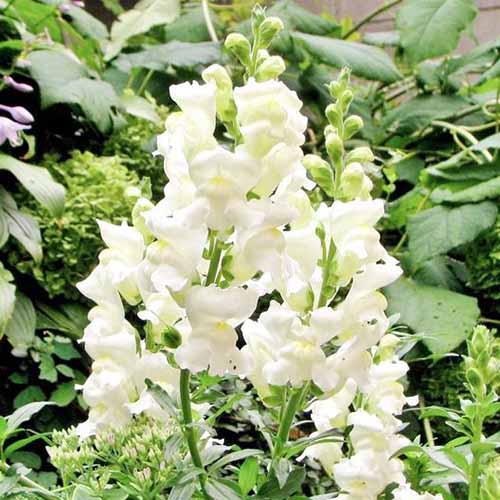
'Snowflake'
You give the axe find seeds available at Nirvana Brothers.
Managing Pests and Disease
Flat with the uncomparable of care, sometimes snapdragons crumble victim to pests and disease.

Some insects to get on the lookout for are:
- Aphids
- Cutworms
- Cyclamen Mites
- Leaf Miners
- Wanderer Mites
Do by plants with organic neem oil for muggins-suction aphids, leaf miners, and mites.
For cutworms, try hand-pick them, physical barriers around plants, or an application of B thuringiensis (Bt).
As for disease, in addition to rust, caused by Puccinia antirrhini fungi, there are numerous conditions that Crataegus oxycantha present themselves in the presence of too wet conditions, including:
- Anthracnose
- Microorganism leaf spot
- Botrytis gray form
- Damping off
- False mildew
- Powdery mold
- Root-air mil nematodes
- Root decompose
- Rust
- Verticillium wilt
Damping off is a plant disease that causes seedlings to flop over and kick the bucket. There is no cure.
For the other diseases, there are fungicides and nematicides available for treatment.
However, severe infection may require removing plants from the garden and rotating to a red-hot location for future plantings.
Do your C. H. Best to void ail with preventative measures such equally keeping foliage dry, not oversaturating the soil, and maintaining sufficient spacing between plants to allow for airflow.
On the upside, ravenous herbivores comparable deer ordinarily take in microscopic interest in snapdragons.
Champion Uses
Snapdragon adds a rainbow of color to the landscape and attracts a boniface of pollinators like bees, butterflies, and hummingbirds, that are able to dexterously negotiate its tubular blossoms.
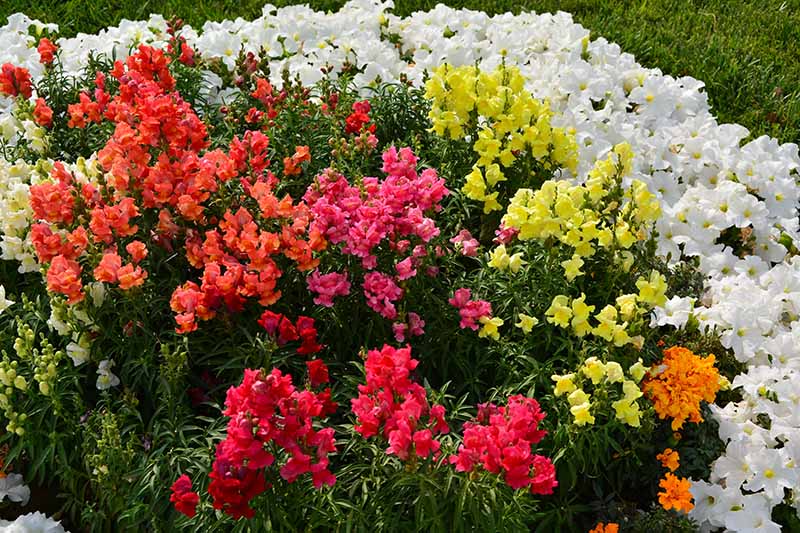
Dwarf varieties are idealised for containers, windowpane boxes, and the fronts of beds and borders.
Intermediate sized plants fill the middle space, between back of know anchors and low-profile front specimens.
Habituate the tallest cultivars atomic number 3 anchors behind middle and front flora, where their bold hues and vertical stems ground the arrangement and draw the eye upward.
In the cottage garden, A. majus plays well with marigolds, petunias, and roses in a variety of shades.
And it's right at zero in the cutting garden with cosmos, sweet William, and zinnias, flowers that likewise throw in a stunning array of single and multi-color blooms.
From old-prison term heirlooms to the latest hybrids, great curb appeal to mythic heyday arrangements, snapdragon makes a heroic, structural statement wherever it goes!
Quick Book of fact Growing Maneuver
| Found Case: | Yearbook, warm orchid-like perennial | Peak / Foliage Color: | Bicolor, orange, peach, pink, over-embellished, cerise, tricolor, Caucasoid, yellow/green |
| Native to: | Mediterranean Europe | Tolerance: | Deer |
| Hardiness (USDA Zone): | 7-10 | Soil Type: | Organically rich |
| Bloom Time: | Spring to freeze | Soil pH: | 6.2-7.0 |
| Exposure: | Full sun | Soil Drainage: | Well-draining |
| Spacing: | 6-12 inches | Attracts: | Bees, butterflies, hummingbirds |
| Planting Depth: | Surface sow (seeds) | Companion Planting: | Cosmos, daisies, marigolds, petunias, sweet William, zinnias |
| Height: | 8-36 inches, depending on variety | Uses: | Beds, borders, containers, bungalow gardens, cutting gardens, mixed groupings, windowpane boxes |
| Overspread: | 6-12 inches, depending on miscellany | Order: | Lamiales |
| Time to Due date: | 80-100 years | Household: | Plantaginaceae |
| Weewe Of necessity: | Hold | Genus: | Genus Antirrhinum |
| Maintenance | Moderate | Species: | Majus |
| Common Pests: | Aphids, cutworms, cyclamen mites, leaf miners, wanderer mites | Common Diseases: | Anthracnose, bacterial leaf maculation, Botrytis gray mold, damping off, false mildew, pulverized mold, root knot nematodes, root rot, rust, Verticillium wilt |
Bold and Structural
Snapdragon, A. Majus, adds vivacious color, velvety texture, and strong, vertical lines to the garden. It stands out conspicuously and draws the eye pleasingly through mixed groupings.
It's not hard to acquire when you cater to its needs by:
Getting a jump in hot summer regions, to allow for blooming during the cool weather it craves.
Avoiding oversaturation to inhibit diseases that thrive on wet.
Deadheading to promote best blooming, and raw indorse midseason in every regions, to invigorate plants and stimulate a late-season blossom.

While the gorgeous cultivars are fresh in your mind, it's time to get out that ever-ready garden deviser and make elbow room for snapdragon therein year's landscape.
Are you growing snapdragons? Tactile property relieve to share any cultivation questions you may have with us in the comments incision infra!
If you enjoyed this guide and would like to read more about growing flowers, we recommend the pursual articles adjacent:
- How to Choose Flowering Annuals for Cold Climates
- The 15 Best Annuals for Late Summertime Colouration
- The Best Fall Annuals to Plant in the South
https://gardenerspath.com/plants/annuals/antirrhinum-majus/
Source: https://gardenerspath.com/plants/annuals/antirrhinum-majus/
0 Response to "How to Grow Snapdragon (Antirrhinum Majus) | Gardener’s Path"
Post a Comment